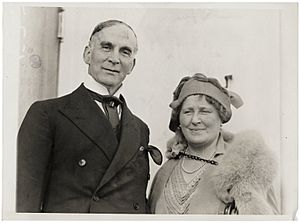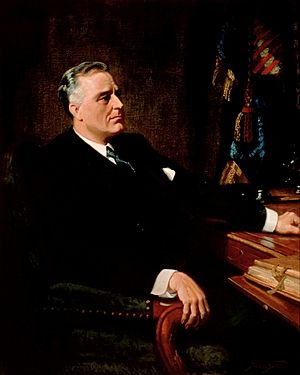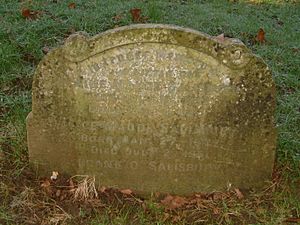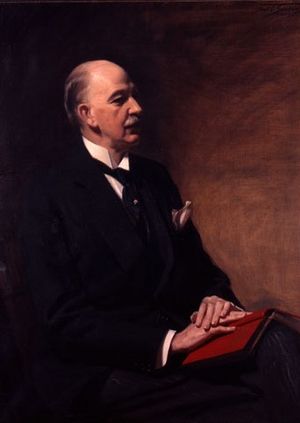Frank O. Salisbury facts for kids
Quick facts for kids
Francis O. Salisbury
|
|
|---|---|

Frank and Alice Salisbury on board the S.S. Olympic in New York City, 1932
|
|
| Born | 18 December 1874 |
| Died | 31 August 1962 (aged 87) |
| Other names | Frank |
| Education |
|
| Occupation | Artist |
| Spouse(s) |
Alice Maude Greenwood
(m. 1877; died 1951) |
| Children | At least 3. |
Francis Owen Salisbury (born December 18, 1874 – died August 31, 1962) was a famous English artist. He was known for painting portraits of people, big pictures of important historical events, and beautiful stained glass windows. He also drew pictures for books. At one point, he was very successful in both England and America. People even called him "Britain's Painter Laureate." He liked traditional art and wasn't a fan of modern art, especially artists like Pablo Picasso.
Contents
Early Life and Art Training
Francis Salisbury was born on December 18, 1874, in Harpenden, England. He was one of 11 children. Because he was often sick, he was mostly taught at home by his sister, Emilie. He only went to a formal school for a few weeks. His first job was fixing bicycles at his father's shop.
When he was 15, his family decided he should learn a trade. He became an apprentice to his older brother, Henry James Salisbury. His brother ran a large company that made stained glass. Francis quickly learned how to make stained glass. He was especially good at adding painted details to the glass before it was fired.
His brother saw his talent and helped him attend Heatherley’s School of Art three days a week. This helped him start a career in painting.
Royal Academy Success
Later, Francis won a scholarship to the Royal Academy Schools. He studied there for five years. During this time, he won two silver medals and two scholarships. One scholarship, called the Landseer scholarship, allowed him to travel to Italy in 1896.
From 1899 to 1943, he had 70 of his paintings shown at the annual Royal Academy Summer Exhibition. However, he was never asked to become a member of the Royal Academy, which made him quite sad.
In 1901, he married Alice Maude. They had several children, including twin daughters named Monica and Sylvia. His first painting shown at the Royal Academy was a portrait of Alice. He often painted pictures of their children.
Francis Salisbury died on August 31, 1962. He passed away at Sarum Chase, a large house he built in London in 1932. He is buried in a simple grave in St Nicholas Churchyard, Harpenden. His baby daughter, Elaine Maude, and his wife are buried with him.
Famous Portraits
Francis Salisbury is best known for his portraits. He could paint them very quickly. He practiced by painting his twin daughters every morning for an hour. He started his career painting children and important people in his local area.

A lucky meeting with Lord Wakefield helped him become known for painting society portraits. Lord Wakefield was a wealthy businessman and helped Francis meet important people. Francis was chosen to paint a picture about the Boy Cornwell from the Battle of Jutland. This brought him to the attention of the Royal Family.
Painting Royalty and Leaders
Francis Salisbury painted 25 members of the British Royal House of Windsor. He was the first artist to paint HM Queen Elizabeth II. In 1919, he painted a large mural for the Royal Exchange, London. It showed a peace service at St Paul's Cathedral.
He painted Winston Churchill more times than any other artist. Two famous images of Churchill, The Siren Suit and Blood, Sweat and Tears, were painted by Salisbury. Another portrait, called the "Freedom Portrait," was the only one Churchill sat for during World War II. It celebrates Churchill receiving the Freedom of the City of London.
Salisbury also painted many mayors, including Samuel Ryder (who started the Ryder Cup golf tournament). Other important people he painted include Richard Burton, Andrew Carnegie, Maria Montessori, and Benito Mussolini.
Success in America
Francis Salisbury was very successful in the United States. He visited America 13 times. He worked in Washington DC, Chicago, and New York City. He painted many wealthy Americans. He painted six US Presidents. His portrait of Franklin D. Roosevelt is still the official White House portrait today.
He also painted many powerful business leaders. These included Henry Clay Folger, Will Keith Kellogg, Andrew Mellon, and John D. Rockefeller Jr..
Salisbury painted several pictures of himself. One shows him painting the 1937 Coronation. Another shows him as Master Glazier in 1934.
Painting Important Events
Salisbury was very good at painting large pictures of historical and national events. He painted over 40 of these big canvases. He was almost the only artist doing this kind of work until 1951. Two of his most important works are The Heart of Empire – the Jubilee Thanksgiving in St Paul's Cathedral 1935 and The Coronation of their Royal Majesties King George VI and Queen Elizabeth 1937.
Even though he was a peaceful person, his war art helped him meet royalty and politicians. He painted portraits of soldiers who died in the First World War. After the Boy Cornwell painting, he painted The King and Queen visiting the Battle Districts of France. The Royal Family also asked him to paint two large pictures of The Burial of the Unknown Warrior for the first Remembrance Day.
During the Second World War, he painted The Signing of the Anglo-Soviet Treaty. One of his well-loved paintings is The Briefing of an Air Squadron.
Two of his paintings are in Walsall Town Hall's theatre. They were made to remember the brave actions of the South Staffordshire Regiments in World War I. One shows soldiers attacking a place called Hohenzollern Redoubt. The other shows them storming the St. Quentin Canal.
His painting India's Homage to the Unknown Warrior in Westminster Abbey was shown at an exhibition in 1924. It showed Indian officers paying tribute to the Unknown Warrior. This painting is now in the British Library.
Faith and Art
Francis Salisbury was a Methodist and took his faith seriously. He believed his artistic talents were a gift from God. He worked very hard and had strong moral beliefs. He created many works for Christian groups, especially Methodists and the Salvation Army.
He painted portraits of important Methodist figures. Perhaps his most famous is the image of John Wesley in John Wesley's House in London. Salisbury even paid for the restoration of Wesley's House in 1934. He supported the idea of Prohibition in the US. He also refused to work on Sundays.
Many of his friends and people he painted, like Pierpont Morgan and Lord Wakefield, were also wealthy businessmen and Christian givers. He left his home, Sarum Chase, to the British Council of Churches. His portraits included people like Billy Graham and Pope Pius XII.
Stained Glass Art
Stained glass remained Francis Salisbury's favorite art form, even if it wasn't his most profitable. One of his earliest stained glass pieces is the east window of St. Michael and All Angels Church, Bassett, in Southampton. It shows Christ, knights, and angels.
He designed 34 stained glass windows. The largest collections are at Wesley's Chapel in London, a former children's home chapel in Harpenden, and the Forest Hill Methodist Church in London. Most of his stained glass was installed in England. However, three notable exceptions are in Medak Cathedral in India. In 1933, he was chosen as Master of the Worshipful Company of Glaziers and Painters of Glass.
Images for kids
The copyright for almost all of his paintings belongs to the Estate of Frank O. Salisbury. You can find authorized images in the books listed below. Important collections of his work are held at the Chicago Historical Society, National Portrait Gallery in London, New York Genealogical and Biographical Society, Royal Air Force Museum in London, Wesley’s Chapel in London, and the World Methodist Headquarters in North Carolina.
See also
 In Spanish: Frank O. Salisbury para niños
In Spanish: Frank O. Salisbury para niños



